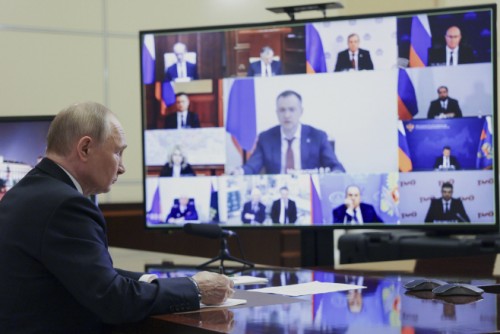 |
| Russian President Vladimir Putin chairs a cabinet meeting via video conference from his residence in Novo-Ogaryovo on the outskirts of Moscow on June 4. / Source: AP, Yonhap News |
Russian President Vladimir Putin plans to retaliate against Ukraine after a massive drone strike on Russian long-range bombers, U.S. President Donald Trump said on June 4.
Posting on Truth Social, Trump revealed he had spoken with Putin for one hour and 15 minutes and wrote, “President Putin very strongly stated that he will have to respond to the recent air base attacks.”
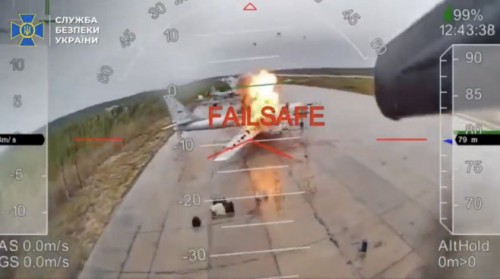 |
| A photo captured from video released by Ukraine’s Ministry of Defense shows Ukrainian drones attacking Russian aircraft, including A-50 airborne early warning planes, Tupolev Tu-95 bombers, and Tu-22 supersonic bombers, at Belaya Air Base in Irkutsk, Siberia, about 3,000 miles (4,828 km) from Ukraine, on June 1. According to a NATO official, around 40 aircraft were damaged and between 10 and 13 were destroyed in the strike. / Source: UPI, Yonhap News |
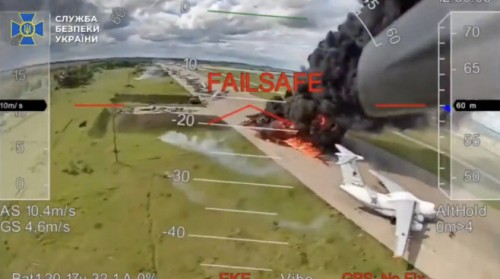 |
Kremlin aide Yuri Ushakov confirmed the two leaders had discussed the drone strikes at length. According to Russia’s RIA Novosti, Ushakov said Trump found Russia’s assessment of the attacks “very useful.”
Ukraine’s Security Service (SBU) said it launched the coordinated strike on June 1, just before the second round of Ukraine-Russia talks in Istanbul, using 117 drones to hit four Russian air bases—two in Irkutsk, Siberia, and others near Norway’s border in Murmansk. The attack reportedly damaged 41 aircraft, including A-50 airborne early warning planes, Tu-95 and Tu-160 strategic bombers, Tu-22 supersonic bombers, and An-12 and Il-78 transport aircraft.
At least 13 aircraft, including eight Tu-95 bombers, were destroyed, according to The Washington Post. The UK’s Telegraph reported that two A-50 aircraft were damaged. With only seven A-50s in Russia’s fleet, each worth an estimated £235 million ($435 million), the losses are considered severe.
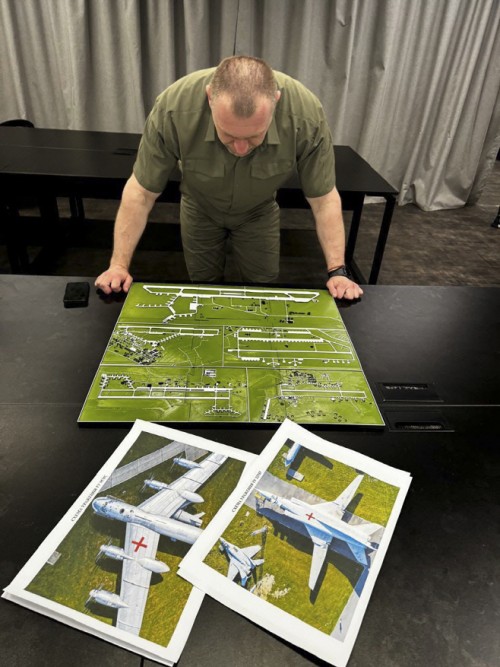 |
| This photo released by Ukraine’s Security Service (SBU) on June 1 via Telegram shows SBU chief Vasyl Maliuk examining a map marking the positions of Russian strategic military aircraft at an undisclosed location in Ukraine. / Source: EPA, Yonhap News |
While Trump has remained uncharacteristically silent about the strike on one leg of Russia’s nuclear triad, Reuters reported that Moscow is pressuring Washington and London to restrain Ukraine.
Russia and the U.S. together control about 88% of the world’s nuclear arsenal, each fielding strategic bombers, ground-based intercontinental ballistic missiles (ICBMs), and submarine-launched ballistic missiles (SLBMs).
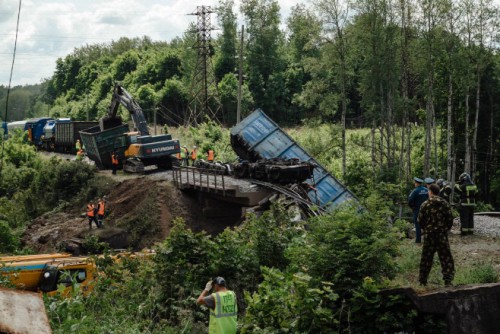 |
| This photo released via Telegram by Alexander Khinshtein, acting governor of Russia’s Kursk region, on June 1 shows rescue operations underway at the site of a collapsed railway bridge in the Kursk region. / Source: AFP, Yonhap News |
In a separate video meeting with Russian officials on June 1, Putin accused Ukraine of terrorism for bombing bridges in Russia’s Bryansk and Kursk regions, which killed and injured dozens of civilians.
During his first phone call with newly elected Pope Leo XIV, Putin again labeled the attacks “clear acts of terrorism under international law,” according to the Kremlin. Ushakov also told Trump that Ukraine was deliberately targeting civilian infrastructure to sabotage peace talks.
However, at the June 2 negotiations, Russia offered terms that were widely seen as an ultimatum, showing no genuine intent for a ceasefire. According to state-run TASS, Russia’s demands include international recognition of its annexation of Crimea, Donbas, and other occupied Ukrainian territories; a pledge from Ukraine to remain militarily neutral; a ban on foreign military presence in Ukraine; and strict limits on Ukraine’s armed forces.
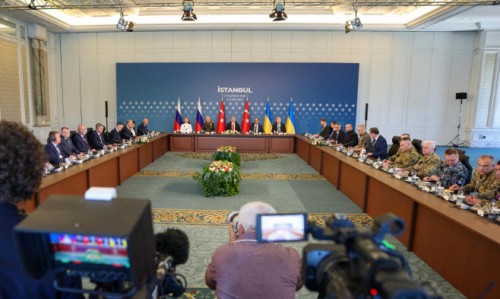 |
| Russian (left) and Ukrainian (right) delegations hold their second round of peace talks at Dolmabahçe Palace in Istanbul, Türkiye, on June 2. The Turkish delegation, acting as mediator, sits in the center. / Source: Xinhua, Yonhap News |
Meanwhile, the European Union is preparing its 18th sanctions package against Russia and hopes the U.S. will participate. European Commission President Ursula von der Leyen told Politico that she recently discussed joint sanctions with U.S. Senator Lindsey Graham (R-SC), a close Trump ally.
Graham and Senator Richard Blumenthal (D-CT) have introduced a bipartisan bill proposing a 500% tariff on U.S. imports from countries buying Russian oil or uranium.
Also on June 4, Ukrainian presidential chief of staff Andriy Yermak met U.S. Secretary of State Marco Rubio in Washington, D.C., to request more air defense support and additional sanctions against Russia.
As the war enters its fourth year, Russian casualties are reportedly staggering. A new report from the Center for Strategic and International Studies (CSIS) estimates that Russia’s cumulative casualties now exceed 950,000 and could surpass 1 million this summer.
In May, Russia was losing an average of 1,209 troops per day—down from the peak of 1,570 last December, but still far higher than in 2022, when the daily average was in the 500s. CSIS estimates Russian fatalities at about 250,000, far exceeding losses in any post-WWII conflict involving Soviet or Russian forces—including the Korean War, Hungarian uprising, Afghanistan, Chechnya, Crimea, and Syria.
Ukrainian forces are estimated to have suffered around 400,000 casualties, including 60,000 to 100,000 dead.
CSIS concluded that Russia’s hopes for victory now largely hinge on a possible halt to U.S. military aid to Ukraine.
Most Read
-
1
-
2
-
3
-
4
-
5
-
6
-
7





















